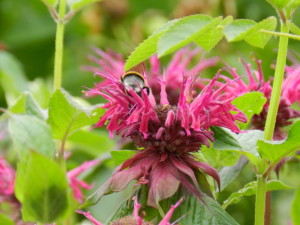
Alllium ‘Millenium’ with butterfly
Did you know that seventy-five per cent of all flowering plant species need help from pollinators to reproduce or that one third of all foods and beverages produced are reliant on pollinators? Last year, an impressive number of organizations launched the Million Pollinator Garden Challenge (MPGC), a nationwide call to action to preserve and create gardens and landscapes that help revive the health of bees, butterflies, birds, bats, and other pollinators across the United States. This challenge includes container gardening. A secondary goal is reconnecting people with the outdoors where they can make the connection between pollinators and the healthy food people eat.

Monarda with bee
The MPGC is encouraging everyone to buy pollinator-friendly seeds and plants and to register those plantings at www.pollinator.org so that your landscape or garden can be added to the map of pollinator gardens. Most fields are optional. Only the ones marked with an orange exclamation point are required. MPGC hopes that one million pollinator gardens will be registered by December 2016. Also at this website, on the home page, is the heading Plant Guides. If you click on it, it will take you to a page of ecoregional guides that include basic information plus plant lists.
Pollinator gardens should use plants that provide nectar and pollen sources, provide a water source, be situated in sunny areas with wind breaks, create large groupings of native or non-invasive plants to increase pollination efficiency, establish continuous bloom throughout the growing season, and eliminate or minimize the use of pesticides.

Butterfly on field of Verbena bonariensis
Not on the ecoregional list for this area is Verbena bonariensis but I’ve had it in my garden for years. This non-hardy but reseeding South American annual is a beautiful lavender presence from June until frost and always seems to have butterflies hovering on it.

Cephalanthus occidentalis flowers
I do have many of the shrubs and perennials that are listed: Ceanothus americanus (New Jersey Tea), Cephalanthus occidentalis (Buttonbush), Salvia, Geranium spp, Lupinus perennis, Aquilegia (I have A.vulgaris, not A.canadensis but the bees don’t seem to care), Baptisia, Echinacea, Phlox, Actaea racemosa, Aster spp, Monarda, Eupatorium (Joe-Pye), Liatris, Lobelia, and Spigelia marilandica (Indian Pink). These are all natives but many non-natives also attract pollinators.

Lupinus perennis
Lupinus perennis ,a true blue lupine, is just as easy to grow as the hybrids and will seed. It is pollinated by several bee species.The slightly pyramidal spires are composed of an infinite number of small florets that open from the bottom up. Give them space so that the lovely divided, fan-like foliage can be appreciated after the plants are finished blooming. The large seedpods also add another season of interest to the garden. All lupines need well drained, organic soil. If you love blue, lupines are a no-brainer.
For those of you who may be interested, I have ordered Lupinus perennis for a client for spring but could order more. All of the other plants I have mentioned are available locally except for Spigelia which I can also order.

Spigelia marilandica
Most shade plants tend to bear pastel flowers but Spigelia marilandica breaks out of that mode. Lighting up the shady garden, its tubular blossoms have bright red sheaths that house bright yellow starbursts. This woodland perennial is visited by butterflies and hummingbirds for whom it is a nectar source. Although clump forming, the clumps do enlarge with time and it may seed. In my garden, the main flush of bloom occurs in late June but Spigelia continues to bloom intermittently through the beginning of September, from the bottom of the stem to the top. This beautiful native is an eye-stopper!
Join the dance.


0 Comments